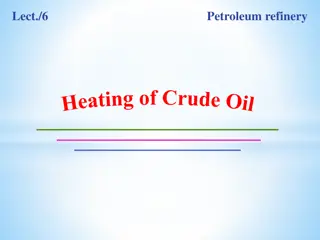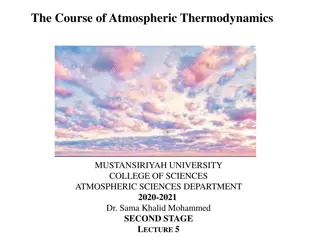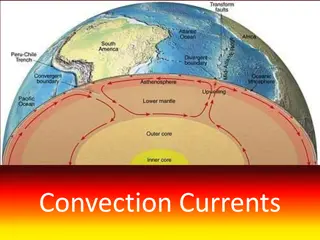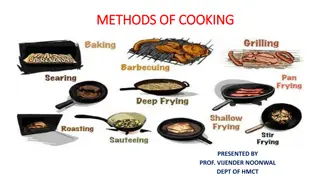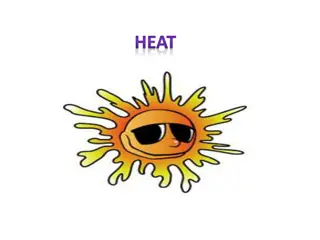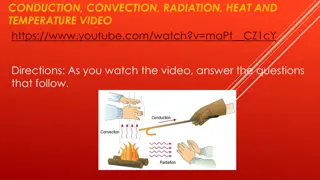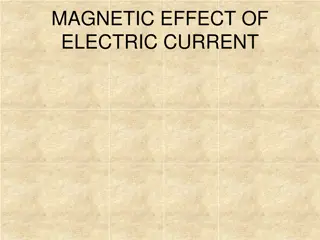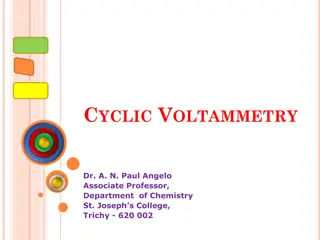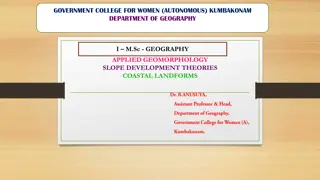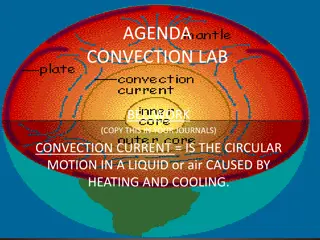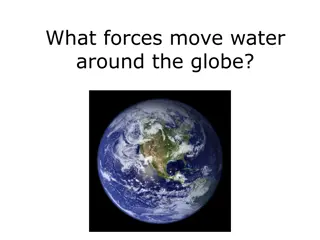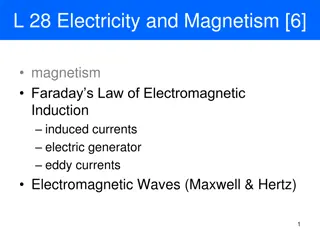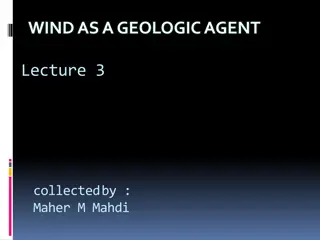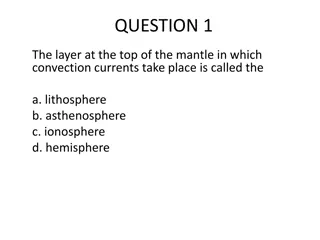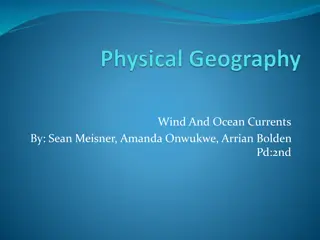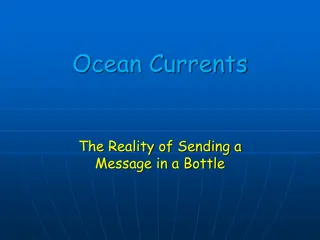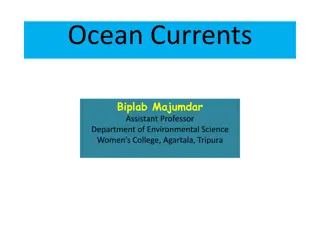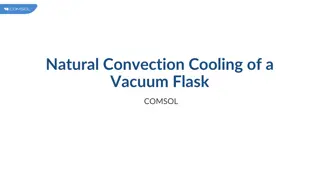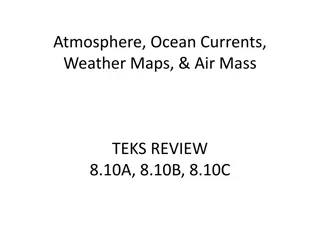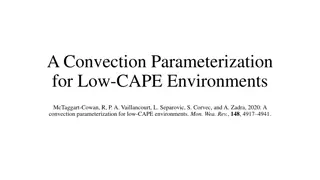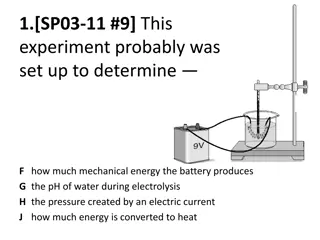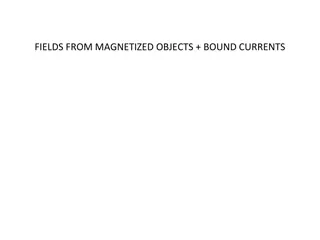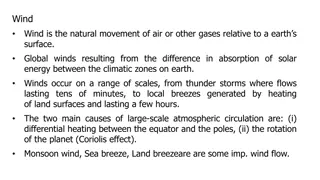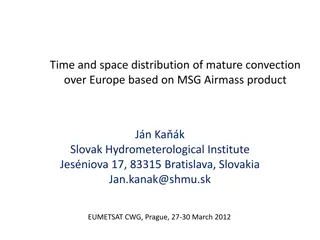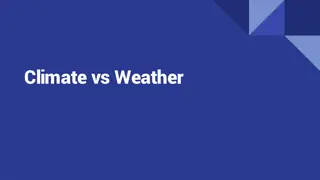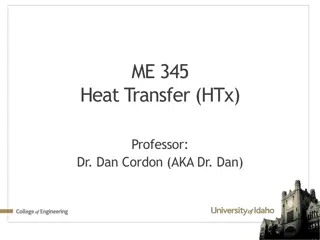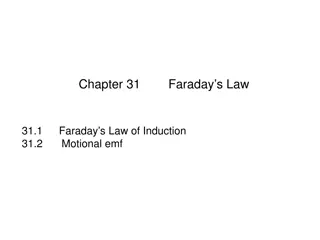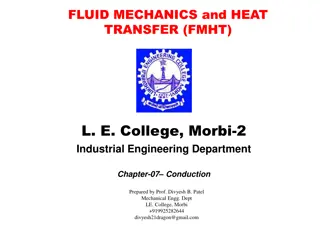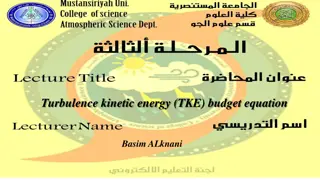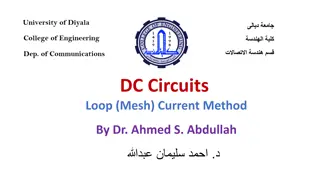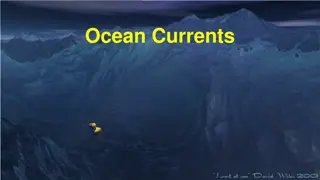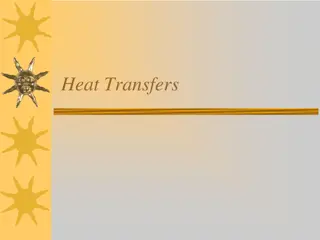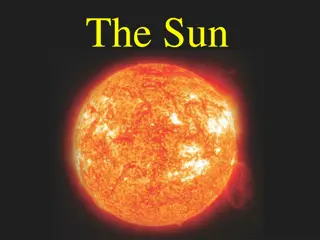Heating of Crude Oil
The process of heating crude oil in petroleum refineries involves various types of furnaces and heat distribution methods. The furnaces can be categorized into box, cylindrical, and radiant wall types, each with separate radiation and convection sections. Design considerations include heat transfer
1 views • 24 slides
Understanding Atmospheric Thermodynamics in Second Stage Lecture
Explore key concepts in atmospheric thermodynamics, including condensation level, free convection level, and the use of thermodynamic diagrams. Learn about the process of condensation, stability levels in the atmosphere, and the significance of free convection in weather patterns. Discover why therm
0 views • 27 slides
Understanding Convection Currents in Earth's Systems
Convection currents refer to the movement of heat by fluids like liquids and gases, transferring heat from one place to another. They play a significant role in the geosphere, atmosphere, and hydrosphere of the Earth, influencing phenomena such as plate tectonics, winds, and ocean currents. In the g
0 views • 12 slides
Understanding Cooking Methods: Conduction and Convection Explained
Cooking methods like conduction and convection are fundamental in culinary arts. Conduction involves direct heat transfer through matter, while convection utilizes the movement of fluids for heat transfer. Gravity and buoyancy play crucial roles in natural convection processes, resulting in efficien
1 views • 45 slides
Understanding Heat Energy Transfer and Principles
Heat energy is the result of particle movement in solids, liquids, and gases. It can be transferred through conduction, convection, and radiation. Conduction occurs through direct contact, convection involves the movement of fluids, and radiation transfers heat through empty space. Understanding how
1 views • 14 slides
Understanding Ocean Currents and Effects
Ocean currents play a crucial role in the movement of water across the Earth's surface. Wind-driven surface currents, influenced by the Coriolis effect, move water horizontally and impact climate patterns worldwide. Major currents extend deep below the surface and can move rapidly, while rip current
0 views • 14 slides
Understanding Heat Transfer: Conduction, Convection, Radiation
Explore the concepts of conduction, convection, and radiation in heat transfer through an engaging video. Learn how thermal energy is transferred through solids, liquids, and gases, and understand the role of insulation in preventing heat transfer. Discover why hot water rises and cold water sinks,
0 views • 5 slides
Exploring the Magnetic Effect of Electric Current
Understanding electromagnetism involves recognizing how an electric current in a conductor generates a magnetic field around it. This phenomenon was first observed by Hans Ørsted in 1820, leading to discoveries about magnetic field patterns for various conductor shapes. By studying straight wires,
0 views • 30 slides
Understanding Electrode Reactions in Electrochemistry
Exploring electrode reactions in electrochemistry involves delving into Faraday's law, coulometry, and the importance of sustainable electrode reactions. These concepts help us understand how the quantity of charge passed affects the production or consumption of substances in electrode reactions. As
4 views • 27 slides
Understanding Cyclic Voltammetry in Electrochemical Analysis
Cyclic voltammetry is a crucial electroanalytical technique for studying electrochemical behavior. It involves sweeping potential in a cyclic manner to measure current responses, aiding in understanding redox processes, electron transfer kinetics, and coupled reactions. The technique requires carefu
0 views • 10 slides
Understanding Coastal Landforms: Formation and Characteristics
Coastal landforms are features shaped by erosion and sedimentation processes along coastlines. These landforms, including headlands, cliffs, bays, spits, salt marshes, and beaches, are predominantly influenced by factors such as wave action, longshore currents, tides, and climatic elements like wind
0 views • 35 slides
Understanding Heat Transfer in Science
Investigate and understand the movement of heat between objects through conduction, convection, and radiation. Learn to compare materials that conduct heat with insulating materials, describe heat transfer processes, and design experiments to study heat energy movement. Explore the use of ratio reas
0 views • 31 slides
Explore Convection Currents Lab Activity
Engage students in a hands-on lab activity to observe convection currents in action. The agenda includes bell work about convection, a hypothesis on confetti paper movement in hot water, detailed lab procedures, drawing conclusions with CER format, and thought-provoking conclusion questions related
0 views • 7 slides
Forces Driving Ocean Currents and Water Movement Explained
Explore the forces behind water movement across the globe, including the impact of wind on surface currents and the role of temperature and density in driving deep ocean currents. Discover how cold, dense water sinks while warm, less dense water rises, influencing the circulation of water in our oce
0 views • 21 slides
Understanding Magnetism: Faraday's Law and Induction
Explore the fundamental concepts of magnetism, including Oersted's and Ampere's discoveries, Faraday's Law of Electromagnetic Induction, and the generation of induced currents. Delve into the interplay between magnetic fields and currents as elucidated by Michael Faraday, and learn how changing magn
0 views • 24 slides
Wind as a Geologic Agent in Shaping Landscapes
Wind has played a significant role in shaping landscapes during times of drier climates, being a key geologic agent impacting erosion and deposition processes. The global wind system, driven by factors such as heating from the sun and the rotation of the Earth, creates convection currents that circu
0 views • 31 slides
Earth Science Quiz: Tectonic Plates, Mountains, and More!
Explore your knowledge of Earth's geology with this quiz covering topics like tectonic plate boundaries, famous geologists, mountain ranges, and geological processes. Test your understanding of concepts like convection currents, subduction, continental drift, and more in this engaging quiz.
0 views • 65 slides
Understanding Wind and Ocean Currents: Influence on Weather and Climate
Wind is caused by air moving across the Earth's surface due to uneven heating by sunlight, impacting weather patterns. The interaction of wind and water leads to various weather phenomena like precipitation, influenced by factors such as the El Niño phenomenon. Ocean currents, driven by wind, play
0 views • 12 slides
Understanding Ocean Currents: Causes and Effects
Explore the fascinating world of ocean currents and how factors like temperature, wind, Earth's rotation, and gravity influence their movement. Learn about the impact of ocean water properties on currents, the distribution of surface temperatures, and the role of various forces like solar heating, w
0 views • 19 slides
Understanding Ocean Currents and Their Impact
Dive into the world of ocean currents with Assistant Professor Biplab Majumdar as he explores the different types of currents, such as surface and deep water currents. Discover how surface currents are influenced by factors like global wind patterns, the Coriolis effect, and continental deflections,
0 views • 19 slides
True or False Review - Ocean Currents and Climate Dynamics Quiz
Test your knowledge on ocean currents, climate dynamics, and related phenomena with this engaging true or false review game. Explore concepts such as the influence of global winds on surface currents, the Coriolis effect, the Gulf Stream, deep ocean currents, El Nino events, and more. Challenge your
0 views • 43 slides
Modeling Natural Convection Cooling of a Vacuum Flask in COMSOL
This example demonstrates the modeling of natural convection cooling in a vacuum flask holding hot coffee using COMSOL. It compares two approaches to describe thermal dissipation, focusing on calculating the flask's cooling power over time. Results include temperature analysis, heat transfer coeffic
0 views • 11 slides
Atmosphere, Ocean Currents, Weather Maps, & Air Mass TEKS Review
Explore key concepts related to atmosphere, ocean currents, weather maps, and air mass in this TEKS review. Understand the factors contributing to Earth's uneven heating, the role of convection in ocean currents, the energy sources that drive ocean convection, and the effects of heating on air densi
0 views • 21 slides
Convection Parameterization for Low-CAPE Environments
Many global Numerical Weather Prediction systems face challenges predicting convective activity in low-CAPE environments. This study introduces a convection parameterization scheme based on moisture convergence to better represent convective effects. The scheme focuses on the triggering function, up
1 views • 38 slides
Understanding Heat Transfer in Scientific Experiments
Explore various scientific experiments related to heat transfer, including determining energy produced by batteries, heat convection in gases and liquids, detecting warmth through a door, energy transformations in the Earth system, and optimizing solar heaters. Learn about conduction, convection, ra
0 views • 16 slides
Understand Magnetic Fields and Currents in Solids
Explore the concepts of magnetic fields and currents in solids, including the calculation of magnetic dipole moments, the presence of bound currents in cylinders with uniform magnetization, the distribution of bound currents on different surfaces, and the behavior of magnetic fields in solid cylinde
0 views • 14 slides
Understanding Wind Patterns and Atmospheric Circulation
Wind is the natural movement of air influenced by factors like solar energy absorption, Earth's rotation, and temperature differentials. Local winds arise from small-scale convection currents due to uneven heating. Wind speed changes throughout the day based on air pressure differentials. Monsoons,
0 views • 17 slides
The Theory of Plate Tectonics: Continents in Motion
Earth's crust and lithosphere have changed over geologic time, forming tectonic plates that move due to convection currents. The concept of plate tectonics explains how continents fit together, the existence of a supercontinent called Pangaea, and natural phenomena like earthquakes and mountains. Ea
0 views • 28 slides
Understanding Mature Convection Distribution Over Europe
Analyzing the time and space distribution of mature convection over Europe based on MSG Airmass product from Slovak Hydrometeorological Institute. The data covers various timeframes and processing steps, highlighting the dependence on Sun elevation, daytime hours, and monthly variations. Statistical
0 views • 11 slides
Understanding Climate vs. Weather: Key Differences and Interrelationships
Learn about the distinctions between climate and weather, including their definitions, variables, and how they relate to air masses and geographical factors. Explore the impact of proximity to the ocean, orographic effects, seasonal temperature differences, convection currents, and the Coriolis Effe
0 views • 19 slides
Understanding Heat Transfer in Convection: Key Parameters and Correlations
Explore the fundamentals of heat transfer in convection, focusing on external flow, important dimensionless parameters like Nusselt and Sherwood numbers, empirical correlations, film temperature concept, and local laminar flat plate correlations. Learn about key concepts and equations used in analyz
0 views • 26 slides
Understanding Faraday's Law of Induction and Lenz's Law
Faraday's Law of Induction states that a changing magnetic field induces an electromotive force (emf) in a conductor, producing an induced current. Lenz's Law complements this by determining the direction of the induced current to oppose the change in magnetic field. This phenomenon is demonstrated
0 views • 23 slides
Understanding Heat Transfer: Conduction, Convection, and Radiation
Heat transfer is a fundamental process that occurs through conduction, convection, and radiation. Conduction involves the transfer of heat between particles through direct contact, while convection moves heat within fluids and gases through currents. Radiation is heat transfer through electromagneti
0 views • 13 slides
Turbulence Kinetic Energy (TKE) Budget Equations Overview
The Turbulence Kinetic Energy (TKE) budget equation explores the different terms contributing to the generation and consumption of turbulence in the atmosphere. It delves into the effects of buoyant production/consumption, mechanical (shear) production, and the importance of Term III in free convect
0 views • 12 slides
Understanding DC Circuits: Mesh Current Method by Dr. Ahmed S. Abdullah
The DC Circuits Loop (Mesh) Current Method, explained by Dr. Ahmed S. Abdullah, applies Kirchhoff's Voltage Law (KVL) to find unknown currents in a circuit. This method involves assigning loop currents to loops, applying KVL to each loop, and indicating voltage polarities across all resistors based
0 views • 31 slides
The Importance of Ocean Currents in Global Systems
Ocean currents play a vital role in transporting heat, nutrients, organisms, and influencing weather patterns and climates. They impact commerce, gas exchanges, nutrient exchanges, pollution dispersal, and fisheries. The interaction between surface and deep-sea currents forms the global ocean convey
0 views • 25 slides
Understanding Heat Transfer Methods and Insulation
Explore the various methods of heat transfer such as conduction, convection, and radiation, along with the roles of conductors and insulators in managing heat. Discover why metals feel cool to the touch, how insulated containers work, and the mechanism behind a Thermos. Delve into the concepts of co
0 views • 14 slides
Exploring the Structure and Phenomena of the Sun
Discover the intricate balance and core structure of the Sun, maintained by hydrostatic equilibrium. Energy moves through radiation and convection zones, with convection manifesting as granulation on the photosphere. Eclipses, such as solar eclipses, provide unique opportunities to witness celestial
0 views • 12 slides
Understanding Extended Surface Heat Transfer in Thermal Fluids Laboratory
This laboratory explores heat transfer in a single cylindrical extended surface (a fin) under free and forced convection to understand fin effectiveness and influencing parameters. Various types of fins like rectangular, triangular, annular, and pin fins are discussed, along with primary modes of he
0 views • 19 slides
Understanding Heat Transfer: A Comprehensive Overview
Heat transfer is a fundamental concept in physics, where energy moves from hot to cold objects through conduction, radiation, and convection. Heat is not a substance but a form of energy that speeds up molecules. Conduction transfers heat between substances in direct contact, while convection involv
0 views • 13 slides
